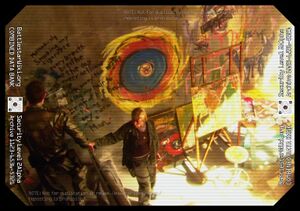Arts and Literature of the Twelve Colonies
| |||||
The Twelve Colonies, like most civilizations, produce objects not merely utilitarian. They have supported literature, including genre pieces, and poetry, allowing for unusual grammatical constructs. Several newspapers are based in various cities, and they have freedom of the press. Colonials have painting, even abstract designs not strictly representative of their reality. They have a variety of musical traditions, as well.
Additionally, many functional items produced on the Colonies adhere to an aesthetic, even at cost to effeciency.
| |||||
You have found a link that leads nowhere... deliberately.
Reasons?[edit]
The reason for this is to clean up the Special:Wantedpages, thus making our lives easier behind the scenes.
So, what links lead here?[edit]
There are too many to bother wasting our time listing. So here's a list of pages that link here.
Literature[edit]
Prose[edit]
Edward Prima/"Dark Day"[edit]
Edward Prima is a Colonial novelist known for his book Dark Day.
Adama, who had Dark Day in his personal library on battlestar Galactica, gives it to Laura Roslin as a gift in the episode "Water". She says that she considers it to be "one of those classics I've never gotten around to reading." Given the context of their conversation, notably Roslin's reference to A Murder on Picon, it is likely a mystery.
Roslin returns the book, to Adama's consternation, after the prognosis of her disease sharply worsens in "Flight of the Phoenix".
"A Murder on Picon"[edit]
A Murder on Picon is a mystery novel, apparently taking place on Picon.
Laura Roslin brought the book with her on the trip to Galactica, (Water) prior to its decomissioning ceremonies (Miniseries).
Poetry[edit]
Kataris[edit]
Kataris was a Caprican poet[1]. Lt. Joe Palladino owns a bound edition of Kataris' poems and threatens Col. Saul Tigh with lines from one:
From the darkness you must fall
Failed and weak, to darkness all.
Kataris is quite well-known amongst colonials. Kara Thrace recognizes the quotation, recalls from which piece it comes, and knows the poem's quality relative to his other works. D'anna Biers identifies Palladino's copy of one of Kataris' books on sight in a recording she is editting (Final Cut).
Periodicals[edit]
Visual Arts[edit]
Representationalist[edit]
Monclair[edit]

Monclair was a Colonial painter. One of his original paintings, a depiction of the Cylon War, adorns William Adama's office on the battlestar Galactica (Bastille Day). He is apparently of considerable renown, given Gaius Baltar's impressed reaction to the piece.
Abstract[edit]
Kara Thrace[edit]

Between tours of duty, Kara Thrace was an enthusiastic painter. Karl Agathon is surprised to discover this side of her when they visit her apartment in Delphi (Valley of Darkness).
Sculpture[edit]
In addition to the Arrow of Apollo, the Delphi Museum of the Colonies contains a large collection of ancient pottery, possibly from the Kobolian period. Located in numerous display cases in the exhibit halls spanning the museum's levels, this large collection of vases, jars, pots and stone fragments form a rough outline of the Colonials' artistic history. Many of the artifacts and art pieces are quite elaborate and appear to be in the detailed Corinthian Style.
Music[edit]
Dreilide Thrace[edit]
Kara's father, Dreilide Thrace, has been described a "frustrated musician."[3] His daughter kept recordings of some of his piano arrangements in her Delphi apartment (Valley of Darkness).[4]
Colonial Anthem[edit]
Forthcoming - use of Colonial Anthem/Original Series theme (by Stu Phillips) in "Miniseries", "Final Cut"
Aesthetics[edit]
Colonial aesthetics lead to an avoidance of right angles, e.g. [TODO]. TODO: layout of Galactica's corridors vs. those of Pegasus.
Octagons[edit]
Colonial printouts, photographs, and videos are not rectangular; the corners are trimmed at 45 degree angles, creating snub rectangles, i.e octagons. The reasoning for this is likely based on their aversion to right angles, as rectangles are, particularly for paper, more effecient.
Hexagons[edit]
Colonial playing cards and dogtags are hexagonal. The reasoning for the cards likely parallels that for the paper. The dogtags likely reflect both the dislike of right angles and the simplicity of polygons over curved shapes.
Architecture[edit]
Old Period[edit]
(Note, that name is non-canon and should not be mistaken for fact. It is used for reference only)
This form of architecture is seen in the two Unnamed Cities of Caprica. Buildings constructed in this style look much like they do in present-day North America, utilizing cinderblock, steel and cubic forms. Streetlights and lamposts in these cities are also built in an older style, being made of cast iron and occasionally sporting elaborate detail.
Federal Period[edit]
This was the style most often seen in Caprica City before its destruction. Buildings constructed in this style were often quite imaginative in their use of shapes, utilizing various polygons and 3-dimensional figures including cylinders, prisms and pyramids with various steepness of the lateral faces. These buildings tended to be metallic steel and glass creations and often went unpainted. The exception to the Federal Period rule was the Riverwalk Complex, an elevated concourse constructed of concrete and glass.
Kobolian[edit]
All that was seen of Kobol's architecture onscreen were the Opera House ruins in Home, Part I. This building was wrought of sandstone and utilized decorative columns and pillars. The rest of the ruins of the City of the Gods appears to be stonework as well. In addition to this stone, in the same episode, Roslin looks at schematics for the City of the Gods. It's public buildings, such as the Forum and the Opera House were made of a reddish stone. The Forum was capped with a black dome and surrounded by pillars and columns. Other structures appear to resemble the Federal Period buildings, utilizing cylinders, 3-D shapes and glass.
Notes and References[edit]
- ↑ The name "Kataris" is probably a reference to the Roman poet Catullus.
- ↑ The original production art is available at Galactica Station.
- ↑ Skyone biography. See Kara Thrace#Notes for full text.
- ↑ The piece attributed to Kara's father is actually Metamorphosis One, composed by Philip Glass, from his 1989 album Solo Piano.

